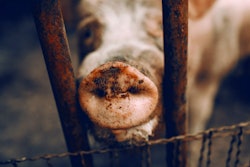
While more outbreaks of ASF are reported in domestic pigs in India, North Korea and the Philippines, there are signs that the disease situation may be easing in China and Myanmar.
More than 11,000 pigs on the island of Luzon have been affected in 58 African swine fever (ASF) outbreaks, according to the latest report from the agriculture ministry in the Philippines to the World Organisation for Animal Health (OIE).
Covering the period from January 23 to April 13, all the animals reportedly belonged to backyard herds varying in size from one to 746 pigs. The outbreaks occurred in multiple provinces across the island.
Since the country’s first outbreak in July 2019, 335 ASF outbreaks have occurred on Luzon, affecting almost 263,000 pigs, according to official reports to the OIE.
This month, Manila Bulletin reported that the Visayas is the only island group of the Philippines that has not yet reported any cases of ASF. As well as on Luzon, outbreaks have been reported on Mindanao since February, leading to the deaths of “hundreds of pigs.”
As losses of pigs mount, the Philippines will have a pork inventory shortage amounting to 31 days by the end of 2020, forecasts the Department of Agriculture. Local officials have a difficult balance to achieve between protecting local pig farmers from the spread of ASF, and ensuring adequate supplies of pork.
ASF kills 15,000 pigs in Assam, India
After local media reported India’s first ever cases of ASF this month, further details are emerging of the disease situation in northeastern states.
Already approximately 15,000 domestic pigs have died of the disease in Assam, reports The Hindu. Mortalities have been mounting despite the implementation of control measures. The disease has now spread to six of the 10 districts in the state. To pay the estimated INR1.44 billion (US$19 million) to compensate farmers whose animals have been culled, the Assam government has appealed to the national center for support. India’s national government is opposed to the principle of culling, preferring a policy of slaughtering only those pigs that have tested positive for the virus.
To stop the spread of the infection to domestic pigs, local officials have ordered the digging of a ditch to restrict the movements of an estimated 15,000 wild pigs in a nearby national park.
In the neighboring state of Arunachal Pradesh, local people report seeing more sick and dead wild boar.
More ASF-infected wild boar in South Korea
Over the past week, the agriculture ministry has reported to the OIE that 13 more wild boar have tested positive for the ASF virus.
All these animals were found in the provinces of Gyeonggi and Gangwon, which border North Korea, and are where previous cases have been recorded. They bring the country’s total number of wild boar infected with the virus to approximately 620.
Concerns over ASF situation in North Korea
ASF has been spreading in North Korea, reports Daily NK, and veterinary authorities are again on high alert. Western provinces of North Hwanghae, South Pyongan, and North Pyongan have been hardest hit. The last of these provinces shares a border with China.
Local sources report mortalities among pigs of up to 100% among collective farms and small backyard herds. The situation is exacerbated by the high population of wild boar, feeding domestic pigs on leftover food, unregulated slaughter and sales of pig meat, and improper disposal of infected animals and carcasses.
Recently issuing a series of guidelines on ASF control, North Korean authorities appear to be taking the disease situation seriously.
In the past week, the mass mortality of 6,000 animals at a farm in North Korea has been blamed on ASF, according to the same source. Some of the affected animals were pigs, so ASF cannot be ruled out, but it would not explain the simultaneous mortality of poultry, sheep and goats at the farm.
One year ago, veterinary authorities in North Korea reported the country’s first ASF outbreak to the OIE. The outbreak was in Changang province, which borders both North Hwanghae and China. Since that time, there has been no further information on the ASF situation there.
ASF situation eases in China, Myanmar
ASF is being contained in China, reports the Xinhua news agency. Numbers of cases have been falling since the end of 2018, according to agriculture minister, Han Changfu.
The minister reported that sow numbers are building up again, and pork production in China is recovering. As evidence of the sector’s recovery, he stated that live pig prices have been falling for the past three months. He also warned local officials to maintain vigilance for any signs of the return of the disease.
After a 21-day surveillance period without ASF virus detection, China’s agriculture ministry has announced that restrictions have been lifted in two regions of Longnan prefecture in Gansu province. At the end of March, two groups of pigs in the region had tested positive for the virus.
Veterinary authorities in Myanmar have declared to the OIE that the ASF situation has been “resolved.” During February, the virus was detected in one farm in each of the states of Shan and Kachin. No cases have been reported in these areas since that time. These neighboring states are in the northeast of Myanmar, and share a border with China’s Yunnan province.
There have been no new ASF cases in the south of Vietnam, according to the latest report to the OIE from the agriculture ministry. The most recent confirmed outbreak in this area was in a village pig herd in Ninh Thuan province in mid-August of 2019.
View our continuing coverage of the global African swine fever situation.
















